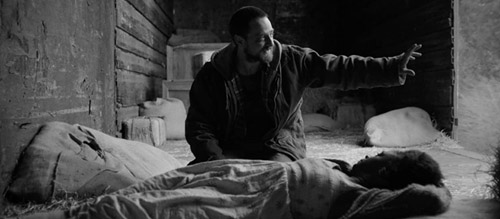Fugitive Dreams (2020) Review – MANIFF
Fugitive Dreams (2020)
Director: Jason Neulander
Screenwriter: Jason Neulander
Starring: April Matthis, Robbie Tann, Scott Shepherd, O-Lan Jones, David Patrick Kelly, Joey Hood, Soleil Patterson, Sean Avery Huber
Next to the Western, the road movie has been the preeminent, nay the default, American movie genre for forever and a day. Journeys in the Land of Opportunity and the ever-present and illusive American Dream have resulted in scores of troubled people searching for something intangible on film. Fugitive Dreams is another such release, albeit an admittedly strange journey in this discipline.
An unassuming black-and-white opening sequence follows a woman who finds a piece of glass in the road, then walks to a gas station bathroom, sings softly to herself in the mirror and proceeds to cut her wrists until she is interrupted by a man clearly under the influence who has been caught short bursting through the door. From here, Mary (April Matthis) and John (Robbie Tann) begin the most unlikely of journeys together.
We have a classic road movie dynamic from the off – a mismatched odd couple, one a nervy motormouth, the other a reserved and standoffish type. The first act is this pair getting to know each other until another obstacle is introduced. Said obstacle is an unwelcome third wheel in their relationship, Scott Shepherd’s Israfel, as well as a strange woman (O-Lan Jones) who communicates only in baby animal sounds and may or may not be Israfel’s mother. Per this shift of group power dynamics, a series of rapidly escalating events occur and danger begins to seep into the ongoing journey.
A good portion of Fugitive Dreams takes place in the confines of a rattling railway carriage like an unadorned off-Broadway play, and it is here where the cast, particularly leads April Matthis and Robbie Tann, can make the most impact, not least because of the lack of stylistic distraction. The performances here are generally naturalistic, the exchanges feel spontaneous and improvised except for some key dialogue that feels more poetic: “Some things aren’t right. You spend your whole life thinking they are, but they’re not”.
We are bequeathed flashes of Mary and John’s former lives, formative moments for them both good and bad – just what have they been through to get here, and have they any real idea where they are going? John’s happiest memories seem to be tied to watching movies at his local drive-in – his childhood is shown to us in Super-8 and in colour, in contrast to Mary’s upbringing which is in the same black-and-white scheme as the majority of the film and contains no fond movie memories to blank out a terrible upbringing; “I don’t like the idea of 20 foot people walking around”, she observes. Further sequences set in the present from John’s point of view are also in colour and tend to be more surreal or hallucinogenic than the rest of the film – what actually happens in this passage is very much up for debate.
Up until the film’s halfway point we are firmly in Terrence Malick waking-dream territory, then there is a palpable shift into something more nightmarish and Lynchian for the film’s second half – random French-Canadian man eating his lunch in the woods and singing Édith Piaf before demanding an S&M demonstration; what are you supposed to mean?
This is clearly a fable, but what it is an allegory for or what morals it is trying to impart remains just out of reach, frustratingly or liberatingly depending on the type of film viewer you are. The flashes of some surreal, religious imagery and the naming of the supporting players (the two travellers that come into conflict with Mary and John are named after an angel of judgement and a goddess of foresight), could all provide clues regarding the storytelling intent.
There is some beautifully simple and evocative imagery here which may reveal more. Mary wades into a pond illuminated by the moonlight as she cleanses/re-baptises herself, subsequently continuing her seemingly endless journey. Young John observes a solar eclipse through a viewfinder as he stands in the wasteland below a tiny drive-in movie screen (“it looks bigger up close”). Colour gradually bleeds into predominantly black and white footage and eventually takes over the film world and characters, who seem to pass into another realm altogether.
There are repeated references to the marks, both physical and otherwise, left by abuse throughout the film. When John asks permission to touch the scar tissue on Mary’s back as they fall asleep, it may be the only moment of innocent and genuine affection she has experienced in a long time. Both have been mistreated, both are lost souls and both come to need each other. He is her confidante, she is his caregiver. There is definitely something here about the transference of trauma, doing unto others what was done to you.
The gentle, strumming folk guitar soundtrack from Nathan Hamilton occasional diverges into bouncy carnival organ and even something unnerving that sounds a lot like that warbling 50s sci-if staple the theremin. The music responds to the lurching tonal style of the film, seemingly becoming more unhinged as the characters and their perception of the world does.
Fugitive Dreams is a challenging but fulfilling and layered watch, a fever dream of a road movie with rich symbolic imagery that can be interpreted in any number of ways. You may find yourself a little weirded out by what seems to occur, or frustrated that no easy answers ever materialise, though anyone will be able to appreciate the sheer filmic beauty and the punchy performances on display.
20/24


